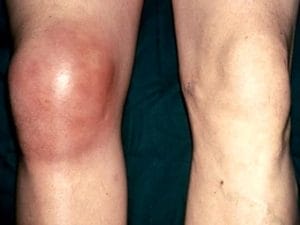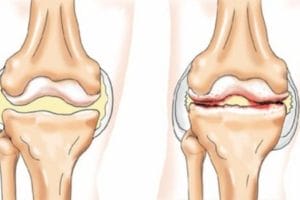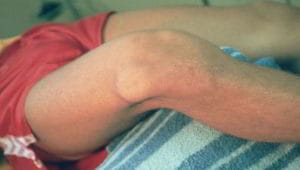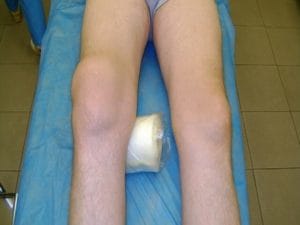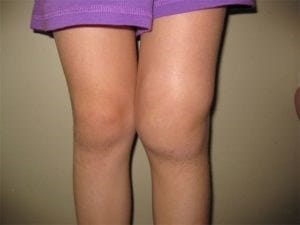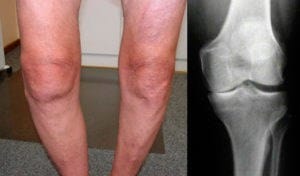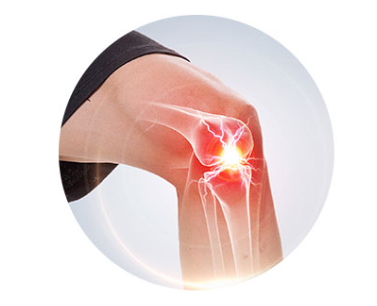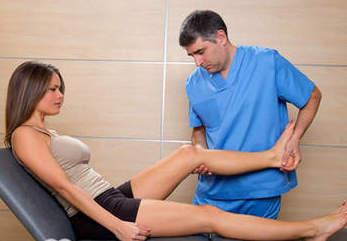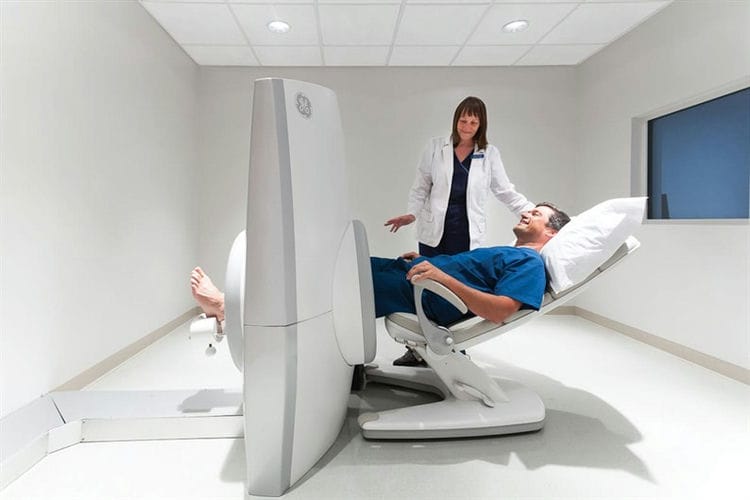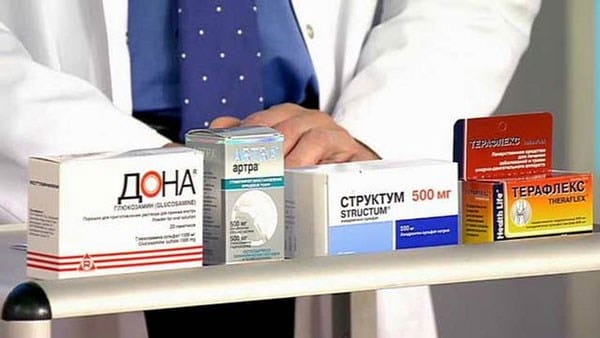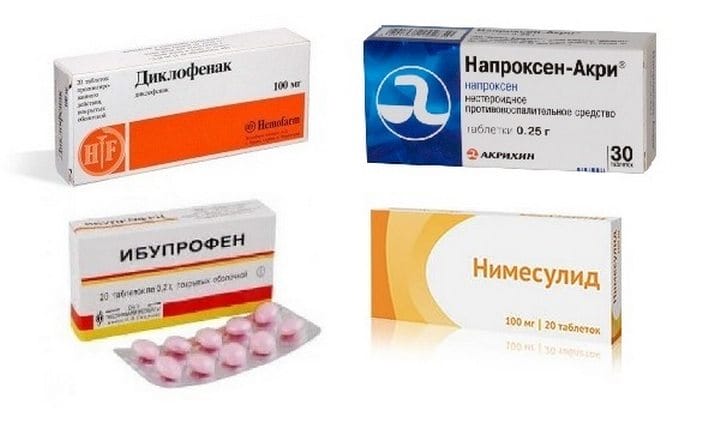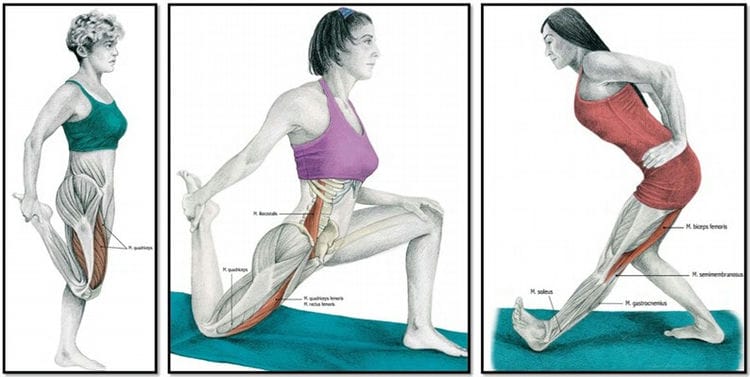Knee anatomy
The knee joint is called complex because it has several articular surfaces. It connects the femur, tibia and patella (patella). The quadriceps femoris is connected to the patella by a tendon that continues with ligaments.
The knee consists of:
- joint bag;
- articular cavity;
- ligaments;
- cartilage;
- articular surfaces of the heads of bones;
- synovial chambers with fluid.
The ligamentous apparatus of the knee consists of the lateral, posterior and intraarticular ligaments. The articular surfaces of the bones are covered with cartilage tissue. The inner and outer menisci (cartilage pads) are located between the mating surfaces of the femur and tibia, so the knee joint is considered complex.
There are bursae in the knee, the size of which has individual variations. Their inner surface emits a special lubricant, synovial fluid. Lubrication allows all parts of the joint to move easily and freely.
The structure of the knee joint
What is a crunch in a joint?
The anatomical structure of a movable joint (including the knee) is very complex. Basically, it is a hinge consisting of a head, a cavity and ligaments. One of the most important components of the joint is the synovial fluid, which serves to soften friction. It contains air or, more precisely, carbon dioxide. So why are joints crunching in knees and other parts of the body?
Flexion and extension change the pressure in the joint. In this case, the bubbles of carbon dioxide burst, making a characteristic sonorous sound, which is called a crunch. After some time (on average – 20-30 minutes), the air again collects into bubbles, and the process is repeated. Sometimes the crunch is quite noticeable, but many people do not pay attention to it. Or the sound is so quiet that you can’t hear it at all.
Sudden movements can also lead to crunching. This happens if the ligament touches the protruding portion of the bone. In addition, in children and adolescents, doctors note increased joint mobility due to the newly developing musculoskeletal system. Over time, tissues become less mobile, and the intensity of sounds decreases.
In other words, knee crunching is a normal physiological process that accompanies flexion and extension of the joint. Why are some people so worried about this? Clinical statistics show that in 15% of the world’s population, this symptom is the primary symptom of arthrosis. That’s why they worry, because with such a disease, jokes are bad. Let’s figure out the causes of the pathological crunch.
The reasons
The reasons why the knees crunch can be divided into two groups: safe and pathological. The former are usually not accompanied by any additional symptoms. However, for prevention, it is still better to consult a doctor, especially if the crunch has arisen suddenly.
Malnutrition
In ordinary life, when a person does not have any health problems, he does not particularly monitor his diet, as a result of which the body does not receive nutrients in full. Cartilage is based on substances such as glucosamine and chondroitin, which serve as a lubricant.
A lack of certain substances in the body can provoke a crunch in the knee
In the absence of serious diseases, problems with knee joints appear no earlier than 45 years old, but if a person diligently engages in weightlifting, for example, squats with a heavy barbell on his shoulders, then more nutrients are needed to maintain healthy knees. Therefore, professional athletes eat a healthy and vitamin-rich diet. Also, in their case, special vitamin supplements containing chondroitin and glucosamine will not be superfluous. They are required to support all joints, not just the knees.
Improper nutrition is one of the possible causes
Drinking compliance is another question to be answered. The fact is that problems with joints in the form of a crunch can appear when there is a lack of fluid, therefore experts recommend drinking at least 2 liters of water per day, and professional athletes – at least 3 liters. This is only pure water, not tea or other drinks.
How is malnutrition different from malnutrition
Disruption of metabolic processes
If during squats you hear a crunch in your knees, but there are no painful sensations, then most likely it is a metabolic disorder. This is not due to a deficiency of useful vitamins and minerals, but to poor absorption. The human body cannot fully absorb food, resulting in excess weight, shortness of breath and increased sweating.
Crunch as a sign of metabolic disorders
Regular crunching or clicking in the knee joints can also occur due to improper lifestyle or genetic characteristics of the body. Moreover, the symptom appears equally in adults and children. If you regularly encounter crunchy sounds in your joints, then it makes sense to reconsider your diet and start leading a more active lifestyle. Of course, the intensity of physical activity should be low.
The intensity of physical activity should be reduced
List of diseases
As noted earlier, not only malnutrition, but also serious pathologies can provoke the appearance of a crunch. As a rule, such a symptom occurs in pathologies that are closely related to mechanical damage, infectious or inflammatory processes that affect cartilage tissue. Below are the most commonly diagnosed diseases that provoke not only crunching, but also other, sometimes painful symptoms.
Table. Diseases causing crunching of the knees.
| Name of the disease, photo | Description |
|---|
Bursitis
| An inflammatory disease affecting the bursa. Most often, pathology occurs with bruises, trauma and other mechanical damage. One of the symptoms of bursitis is a characteristic crunch in the affected joint. |
|---|
Osteophytes
| A pathological condition characterized by the formation of bone growths. It occurs against the background of excessive physical exertion, osteoarthritis or metabolic disorders in the body. |
|---|
Chondromatosis
| Chronic disease of cartilage tissue, diagnosed mainly in professional athletes. It is accompanied by a characteristic crunch in the joints when bending or extending them, as well as pain syndrome, due to which the functionality of the affected area decreases. |
|---|
Damage to the meniscus
| Knee injury, after which knee extension and flexion is accompanied by crunching. Most often occurs with sudden movements. Diagnosis of a damaged meniscus is carried out not only by visual inspection, but also by analysis of joint lubrication. |
|---|
Gout
| Metabolic disease, accompanied by a decrease in the patient’s motor activity. As a rule, gout is diagnosed in patients over 40 years old, which is associated with age-related changes. In addition to the characteristic crunch in the joints, with gout, a severe painful attack occurs, which occurs mainly at night. |
|---|
Rheumatoid arthritis
| Systemic pathology of an infectious nature. The disease is most often diagnosed in mature patients, mostly female. Arthritis develops against the background of hormonal changes in the patient’s body and is accompanied by damage and stiffness of the joints, the appearance of a crunch and other signs. |
|---|
Gonarthrosis
| Joint dystrophic disease that affects some of the cartilage of the knee joint. Gonarthrosis refers to age-related diseases, therefore, this disease is most often detected in adult patients. The characteristic signs of the disease include crunching and stiffness of movements in the affected joint, tissue edema and pain. |
Why does osteochondrosis occur?
On a note! The appearance of a crunch in the knee joint can also be associated with excessive stress on it due to the overweight of the patient or with the course of pregnancy in women. But experts have also found that knee problems can also occur in people with sedentary lifestyles.
Bursting of gas bubbles in the joint
This is the most common cause of crunching.
In the knee there is synovial fluid (a thick elastic substance that acts as a lubricant), in which gases (oxygen, carbon dioxide, etc.) are dissolved. When the joint is flexed, especially when it occurs abruptly, the pressure changes, and the gas that is part of the synovial fluid, bubbles and bursts.
If the knees are crunchy for this reason, no treatment is required.
Congenital increased elasticity of the ligaments
The increased elasticity of the ligaments can be explained either by their congenital weakening (if it is not strong, then treatment will not be needed), or by acquired sprain (in athletes such as gymnasts).
When the ligaments that fix the joint have increased elasticity, the range of motion of the joint back and forth and to the sides increases, which is why it crunches in the knee.
Friction of a ligament or tendon against bone
This friction usually occurs during adolescence and will subside over time. Bones can grow intensively and unevenly, which creates a bulging area, which clings to a ligament or tendon.
Synovial fluid deficiency
If the joint lacks natural lubrication, creaking sounds appear when flexing and extending. This is accompanied by pain that gets worse with physical exertion.
A deficiency of synovial fluid is very dangerous, as friction increases, and the menisci (cartilage plates in the joint) wear off over time. This leads to a limitation of his mobility and to increased pain.
Injuries to the meniscus or patella
Menisci are flat plates of cartilage that sit between the femur and the tibia at their junction.
They can be injured not only as a result of a blow or a fall, but also due to heavy physical exertion, prolonged use of high-heeled shoes, surgical interventions with complications, and obesity. The meniscus is depleted and with arthritis, arthrosis. With a thinning of the meniscus, the knee crunches and hurts. When it is broken or torn off, the knee crunches, it swells, and there is also acute pain.
The patella is the bone that covers the front of the joint. Normally, its posterior surface is smooth. But as a result of increased stress, it can become uneven and interfere with the work of the joint. At the same time, it crunches and creaks in the knee, and pain occurs during flexion and extension.
Also, the patella can be deformed as a result of injury. Then he, too, will touch the joint, and the knee will crackle.
Types of meniscus injury
Ligament problems (injury, loosening)
Injuries (sprains or tears) of the ligaments occur with sudden or too intense physical exertion, sometimes with falls.
Weakening of the ligaments can be associated with age-related changes in the body, improper diet and bad habits, and a sedentary lifestyle.
Usually, problems with ligaments are accompanied not only by a crunch in the knee, but also by pain, swelling, and disruption of the joint.
When to see a doctor
Crepitus during joint movement is a common occurrence that people often encounter while squatting or climbing stairs. But the appearance of a crunch is not always a good reason for visiting a doctor, since without accompanying symptoms, extraneous sounds do not require medical intervention. If tissue swelling or pain appears along with the crunch, then you need to visit the doctor’s office as soon as possible.
You don’t always need to see a doctor
If the resulting crunch is chronic, then an orthopedic consultant is required. You need to understand that with timely diagnosis of the problem and timely treatment started, you can quickly get rid of the pathology without any serious health consequences. Also, a timely visit to a specialist will relieve the symptoms that have arisen and restore the motor functions of the knee joint.
At the appointment with an orthopedist
Which doctor to contact for knee pain
If a person is at a loss as to which doctor to go to if there is a crunch or pain in the knee, then a therapist should be visited for an initial examination. The specialist will collect an anamnesis of the disease, issue a referral for diagnostic procedures, and, if necessary, refer the patient to a doctor of narrow specialization.
Depending on the reasons that provoked unpleasant discomfort, the patient will need consultations:
- rheumatologist;
- traumatologist;
- orthopedist;
- osteopath;
- neurologist;
- arthrologist.
To avoid exhausting walking around the doctor’s offices, it is recommended to first undergo a high-quality instrumental and hardware examination. Laboratory diagnostics for joint diseases is not always informative.
Symptoms and diagnosis of pathology
Characteristic clicks are heard only when driving. If at the same time a person feels pain, then an urgent need to consult a doctor. Additional symptoms in this case are swelling and stiffness of the joint. To accurately determine the pathology, it is necessary to perform a set of measures, because further treatment will depend on this:
- Ultrasound.
- X-ray examination.
- Computed tomography (CT).
- Magnetic resonance imaging (MRI).
- Blood test.
X-rays and CT scans do not always give reliable results due to the fact that cartilage tissue is not displayed on such images. Therefore, doctors prefer MRI, which clearly demonstrates the condition of the joints.
Diagnosing pain and crunching in the knees, the causes of which are often very vague, the doctor necessarily performs an ultrasound of the liver and kidneys. If the liver is responsible for collagen synthesis, then the amount of synovial fluid is directly related to the work of the kidneys. In addition, a laboratory blood test is also recommended to rule out rheumatoid factor.
Diagnostic features
To make an accurate diagnosis, the doctor must first interview the patient to find out several important nuances:
- whether there were suspicious symptoms preceding a crunch in the joints;
- whether there is a genetic predisposition;
- whether the patient has comorbidities.
Patient examination
After a visual examination and questioning of the patient, the doctor may prescribe some diagnostic procedures. Let’s consider the most effective ones:
- MRT;
- knee arthroscopy;
- ultrasound diagnostics;
- X-ray examination.
MRI of the knee
Based on the results of the procedures performed, the doctor will be able to make an accurate diagnosis, and as soon as the exact cause of the crunch is known, the patient will be prescribed an appropriate course of therapy. The effectiveness of treatment largely depends on the period of development of the pathology, therefore, it is categorically not recommended to ignore suspicious symptoms while waiting for them to disappear themselves.
Treatment methods
To achieve the maximum therapeutic effect in the treatment of crunch in the knee joint, an integrated approach is required, consisting of taking medications, therapeutic exercises, proper nutrition, massage and traditional medicine. Let’s take a look at each of these methods separately.
Medication
Depending on the causative factor that provoked the appearance of a crunch in the joint, the patient may be prescribed the following groups of drugs:
- vitamin complexes containing phosphorus and calcium;
- corticosteroid drugs, in the chemical composition of which hormones are present;
- external remedies – relieve painful symptoms and restore the mobility of the affected joint;
- chondroprotectors in the form of capsules or ointments – strengthen the cartilage tissue;
Chondroprotectors
- anti-inflammatory drugs – designed to relieve pain and inflammation that often occur with crunching joints. Most often prescribed when diagnosing arthritis.
Anti-inflammatory drugs
The exact dosage and the list of drugs used are determined by the doctor after a diagnostic examination. Some medications are powerful, especially hormonal medications, so taking them on your own is not recommended.
Non-hormonal anti-inflammatory drugs
Non-steroidal anti-inflammatory drugs (NSAIDs) are used in cases where the disease itself is inflammatory in nature or tissue inflammation is due to a post-traumatic reaction. These funds can be presented in the form of tablets, ointments, injection solutions.
Some active ingredients and drug brands:
- Diclofenac (Voltaren, Naklofen, Diklak).
- Indomethacin (Metindol, Indovazin).
- Meloxicam (Artrozan, Movalis).
Diclofenac injectable form
Indomethacin in the form of suppositories
Meloxicam tablets
Corticosteroids
This group includes hormonal anti-inflammatory drugs. Hormones are considered emergency remedies and are effective in relieving inflammation and pain.
In terms of speed of action and power of the result, corticosteroids are superior to NSAIDs. However, they can only remove an acute reaction, but not cure the disease.
The drugs in this group include:
- Dexamethasone.
- Prednisolone.
- Hydrocortisone.
Hydrocortisone for external use
Prednisolone in the form of an ointment
Dexamethasone in ampoules
Chondroprotectors
These drugs help repair cartilage tissue. They are used for thinning, destruction and deformation of the cartilaginous elements of the knee joint.
There are only three active substances:
- Chondroitin sulfate.
- Glucosamine.
- Hyaluronic acid (injected directly into the joint).
A number of medicines have been developed on the basis of chondroitin and glucosamine, which includes both monopreparations (one substance) and combined (both substances in different proportions).
The most popular remedies are:
- Combined: Artra, Teraflex.
- With glucosamine: Dona, Elbona.
- With chondroitin: Chondrolone, Chondroxide.
Chondroxide ointment
Don in pill form
Teraflex repairs the vertebral disc
Glucosamine with Chondroitin
Collagen
Collagen is a fibrillar protein essential for joint health that is found in cartilage tissue. Ideally, it is independently produced by the human body, but in some cases, its production decreases (for example, with age). There are recommendations to eat jellied meat, jelly and all dishes containing edible gelatin.
However, the assimilation of collagen from food cannot be monitored, therefore, in case of illness, dietary supplements can be taken:
- Collagen Ultra gel (available in powder and cream).
- Collagen (capsules).
- Laura Collagen (as a drink).
Collagen
Collagen
Laura collagen
Vitamin preparations
Vitamin-mineral complexes intended for joints may contain additional supplements in the form of collagen, calcium and other beneficial substances. Examples of drugs: Arthrivitis and Sustanorm.
Physiotherapy
Together with drug treatment, patients are often prescribed special gymnastic exercises aimed at improving the mobility of the diseased joint. Physiotherapy should include such exercises as “bicycle” (perform 20 seconds), squatting using a chair (8-10 repetitions), rotation of the legs bent at the knee joints (8-10 repetitions). Depending on the condition of the joints and the severity of the pathology, the doctor may prescribe other exercises that are of higher or lower intensity.
Healing exercises
Diet
Throughout the entire therapeutic course, the patient must follow a special diet prescribed by the doctor. It consists in increasing the amount of calcium-containing foods in the diet, such as cottage cheese, kefir or milk. It is also recommended to regularly consume low-fat varieties of fish – they are also good for bones and cartilage tissue. It is very important to consume such foods in childhood, when the body is still developing.
Nutrition during treatment
A crunchy joint diet requires the elimination of various sauces from the diet, preservatives, pickles and table salt. It is necessary to abandon the excessive passion for sweets, trying to replace confectionery with fresh fruits and vegetables.
Massage
It is recommended to supplement therapeutic exercises with massage, which is desirable to perform with various creams and ointments that have a warming effect. All actions during the massage should be gentle and gentle so as not to damage the joint. First, apply a small amount of ointment to the skin, then begin to massage the knee in a circular motion. The medicine must be rubbed deep into the skin for maximum effect.
Knee massage
Note! You need to massage not only the front side of the sore knee, but also the back, and after the procedure it must be carefully wrapped with an elastic bandage. It is recommended to massage before going to bed. This will keep your foot calm and warm.
Folk remedies
There are many recipes for folk remedies used to restore cartilage tissue in affected areas. Also, with their help, you can eliminate the unpleasant symptoms that often occur along with crunching in the knees.
Treatment with folk remedies
- Oatmeal lotions. Pour 200 ml of boiling water over 1 tbsp. l. oatmeal and apply the cooked gruel to the sore spot. Keep the lotion warm. After about 30-40 minutes, the application can be removed.
- Spruce broth. Pour 200 ml of pure water over 1 spruce cone and leave it to infuse overnight. Take the finished product by mouth 1 tbsp. l. 2 times a day for 10 days.
- Lemon compress. Mix 10 g of lemon juice with 50 g of vegetable oil and, putting the resulting mass on a clean napkin, apply the finished compress to the sore spot for 40 minutes.
- Homemade ointment. To prepare it, you need to mix alcohol, bee honey and iodine tincture in equal proportions. After mixing, use the prepared grinding solution (great for massage treatments).
Iodine
It is pointless to use traditional medicine without traditional methods of therapy, since they are effective only with complex treatment.
Knee compresses
Applying compresses to the knee joint helps relieve pain and swelling in this area. The following recipes have earned positive feedback from patients and doctors:
- Separate the large cabbage leaf from the head, rinse in warm water and beat with a hammer until soft and juiced. Apply the sheet to the sore spot, fix it with plastic wrap and a cotton bandage. Leave it overnight. If possible, change the leaf after 2-3 hours, because the juice becomes scarce.
- Chestnut flower infusion must be prepared in advance. To do this, fill a 0.5 liter jar with chestnut flowers and pour vodka to the neck. Close the jar and put in a dark place for 1 month to infuse. After 30 days, strain the infusion, heat slightly and use as a rub or compress for 14 days.
- Compress based on the juice of one orange and vegetable oil. Squeeze out the juice and mix with 100 grams of butter. Soak a cotton cloth in the liquid and apply to the knee. Cover with foil and warm cloth, leave for 30 minutes.
Oral decoctions
Potato broth is considered an effective remedy for knee crunching in patients with similar problems. To prepare it, you need to peel a few potatoes and boil until tender without adding salt. Pour the water into a separate container and take 200 ml per day. Store in the refrigerator for no more than a day. It is better to cook a fresh broth using 1-2 root vegetables.
The gelatinous drink helps restore cartilage tissue in the joints as well as drugs sold in pharmacies. To do this, take 5 g of dry gelatin and pour 200 ml of cold water. Leave the product to dissolve overnight. In the morning add another 50 ml of water and drink the total amount at a time. The procedure can be repeated for a long time if there are no side reactions.
Potato broth
Gelatin
Do not consider traditional medicine a panacea for crunching knees and refuse the treatment offered by an orthopedist or traumatologist. These recipes are effective only in complex therapy, and in some cases can only be a preventive measure.
Forecast
Observing all the doctor’s recommendations, you can get rid of crunching knees and other symptoms accompanying joint diseases. The treatment process lasts from several weeks to several months, depending on the pathology and its severity. Sometimes, when the knee crunches, but it does not hurt, treatment is not needed; however, for prophylaxis, it is better to consult a doctor for an examination.
Crunching knees may indicate onset arthrosis
Arthrosis is a formidable disease that is often diagnosed in young boys and girls. This is usually due to increased loads, high-speed rhythm of life, unhealthy diet and excess weight.
It is difficult to suspect immediately arthrosis, especially at a young age. Due to this, doctors cannot make an accurate diagnosis. One of the signs by which one can complain about the presence of diseases of the knee joint is the appearance of an unpleasant and even painful crunch in the knees. If you notice such a sign in yourself, run to see a doctor. The diagnostic measures carried out will help to prevent the onset of arthrosis at a young age in time.
How to prevent crunching in joints?
Crunching knees when squatting, the causes and treatment of which are closely related, is much easier to prevent. Typical clicks in the joints are usually heard during any physical exertion or sudden movement. And if we talk about the likelihood of developing a pathological crunch, then a properly composed diet will help to prevent it:
- Calcium. 1 glass of kefir contains a daily dose of calcium, but any dairy products should be consumed after 14 hours.
- Vitamin A is essential for the normal synthesis of synovial fluid. Found in carrots, pumpkins and other plants.
- Vitamin D is required for calcium conservation. Formed in the body naturally under the influence of sunlight, it is found in the liver, eggs and seafood.
- Hyaluronic acid and chondroitin sulfates are needed for the synthesis of cartilage tissue. Jellied meat is rich in these elements, but they are also formed when cooking chicken legs or fish heads. It will be very beneficial to consume these broths regularly.
- A ban on any smoked products. Better to replace them with boiled and stewed dishes.
In addition, doctors recommend that you go in for sports for preventive purposes. There is absolutely no need to go to the gym and build up huge muscles, simple physical exercises will do that will help restore and strengthen your musculoskeletal system.
Swimming will help from clicks: it is in the water that the load on the joints is minimal. However, you should visit swimming pools that do not add bleach or silver ions for cleaning. The best option would be a natural body of water (sea, lake, etc.), although it is not always possible to swim in the fresh air in the cold season.
Medical research data
New research shows that knees that “crack”, “snap” or “crack” may indicate arthritis in the near future.
 Why do knees crunch when bending and extending? Usually knees get a little noisy and “crackle” during yoga, and then there is probably nothing to worry about, experts say.
Why do knees crunch when bending and extending? Usually knees get a little noisy and “crackle” during yoga, and then there is probably nothing to worry about, experts say.
But in a new study, middle-aged and older adults who said their knees were often crunchy were more likely to develop symptoms of arthritis in the following year.
Of those who complained that their knees were “always” noisy, 11 percent developed knee arthritis symptoms within a year, compared with 4.5 percent of people who said their knees “never” cracked or crunched.
All the others hit the middle. Of the people who said their knees “sometimes” or “often” make noise, about 8 percent developed knee arthritis symptoms in the next year.
Doctors have a term for these joint noises: crepitus.
Patients often complain about this, says Dr. Grace Lo, lead author of the study. She is an Assistant Professor at Baylor College of Medicine in Houston. But until now, it was unclear if crepitus could predict symptomatic knee arthritis. This means that people will not only have evidence of cartilage destruction on x-rays, but also the symptoms associated with it, namely frequent pain and stiffness. Therefore, it is recommended to consult a rheumatologist, orthopedist as soon as possible, undergo examination and treatment. Timely treatment improves recovery from arthritis.
“Our research shows that crepitus is not completely benign,” Lo said. “This is a sign that something is happening in the knee joint.”
Dr. Joseph Bosco, an orthopedic surgeon who was not involved in the study, agreed that frequent crepitus should be checked.
Nearly 3,500 study participants were at increased risk of knee arthritis symptoms, Luo explained.
The age of the participants ranged from 45 to 79 years. Some were at risk of knee arthritis simply due to old age, while others had risk factors such as obesity or a history of severe knee injury.
So it is not clear, Luo said, whether the results will affect, for example, a 35-year-old whose knees crack when he runs.
Plus, while the study participants initially had no symptoms of knee arthritis, some showed signs of arthritis damage on x-rays.
And it was in the group where the crepitus was strongest: people who “often” or “always” experienced knee crunching were nearly three times more likely to develop knee arthritis symptoms than those who “never” there was crepitus.
The results could be helpful in daily medical practice, Luo said. “If patients complain of frequent cracking or crunching in their knees,” she said, “it is worth getting an X-ray.”
If he discovers signs of arthritic damage, then the risk of symptom progression in the near future is likely to be significant.
Unfortunately, there is no magic pill that can stop the development of arthritis. But, Luo said, for severely ill patients, weight loss can help. Some people, she added, may benefit from strengthening the muscles that support the knees.
Conclusion
You learned about the causes and treatment of crunching knees. If your knees crunch, folk remedies can easily cope with this deficiency. However, with a progressive disease (arthritis, arthrosis, etc.), you will have to spend a lot of time and effort to normalize the situation and reverse the pathological process.
The disease is much easier to prevent, so you should pay attention to your health and take the necessary measures in advance.
Sources used and useful links on the topic: https://nehrusti.com/simptomy/khrust-v-kolene.html https://ibeauty-health.com/zdorove/hrust-v-kolenyah.html https: // SustavZdorov. ru / koleni / koleni-hrustyat-310.html https://sustav-expert.com/sustavy-nog/kolennyj-sustav/xrust-v-kolenyax-pri-sgibanii-i-razgibanii-lechenie https: // proartrit. ru / koleni-hrustyat / https://Sustavi.guru/hrust-v-kolenyah.html https://osteomed.su/pochemu-xrustiat-koleni/

